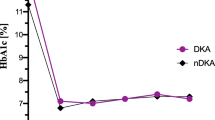Abstract
Clinical characteristics and metabolic control in a large cohort of children with Type 1 diabetes (T1DM) were evaluated. Fifty-three Italian centers for childhood diabetes collected blood samples and clinical records from 3560 consecutive eligible patients aged 1.6–17.10 yr with disease duration >12 months. HbA1c determinations were centralized in a Diabetes Control and Complications Trial-controlled laboratory. HbA1c grand mean was 8.87±1.77%. Thirty-two percent of the patients had HbA1c values <8.0%. Puberty and disease duration were the main determinants of increase in HbA1c levels (<0.001 ). HbA1c values were inversely correlated to the frequency of blood glucose monitoring (p<0.001). Among the total population, 53.7% of the patients had 4 or more injections per day, 37.8% three injections, 7.4% ≤ 2 injections and only 1.1% was on pumps. Daily number of injections increased with age (p<0.001). Hypoglycemia episodes were reported in 17.6% patient-years and diabetic ketoacidosis (DKA) in 1.0% of children, more frequently in those with HbA1c >8.8% (p<0.02). Two thirds of Italian children with T1DM have HbA1c>8% despite regionalized centers, multidisciplinary team approach, free access to appropriate diabetes care, education, frequent blood glucose monitoring and multiple insulin injections.
Similar content being viewed by others
References
Atkinson MA, Eisenbarth GS. Type 1 diabetes: new perspectives on disease pathogenesis and treatment. Lancet 2001, 358: 221–9.
The DCCT Research Group. The effect of intensive treatment of diabetes on the development and progression of long-term complication in insulin-dependent diabetes mellitus. N Engl J Med 1993, 329: 977–86.
The DCCT Research Group. Effect of intensive diabetes treatment on the development and progression of long-term complication in adolescents with insulin-dependent diabetes mellitus: Diabetes Control and Complications Trial. J Pediatr 1994, 125: 177–88.
Mortensen HB, Hougaard P. Comparison of metabolic control in a cross-sectional study of 2,873 children and adolescents with IDDM from 18 countries. Diabetes Care 1997, 20: 714–20.
Danne T, Mortensen HB, Hougaard P, et al. Persistent differences among centers over 3 years in glycemic control and hypoglycemia in a study of 3,805 children and adolescents with type 1 diabetes from the Hvidøre Study Group. Diabetes Care 2001, 24: 1342–7.
Vanelli M, Chiarelli F, Chiari, et al. Metabolic control in children and adolescents with diabetes experience of two regional centers. J Pediatr Endocrinol Metab 1999, 12: 403–9.
Vanelli M and Italian Childhood Diabetes Group. Medical care for children with diabetes. Ital J Pediatr 1995, 21: 897–9.
ISPAD Guidelines 2000. Ed. PGF Swift. Publ. Medforum, Zeist, The Netherlands.
Rosilio M, Cotton JB, Wieliczko MC, et al. Factors associated with glycemic control. A cross-sectional nationwide study in 2,579 French children with type 1 diabetes: the French Pediatric Diabetes Group. Diabetes Care 1998, 21: 1146–53.
Mortensen HB, Hartling SG, Petersen KE, the Danish Study Group of Diabetes in Childhood. A nation-wide cross-sectional study of glycosilated haemoglobin in Danish children with type 1 diabetes. Diabet Med 1988, 5: 871–6
Scottish Study Group for the Care of the Young Diabetic (SSGCYD). Factors influencing glycemic control in young people with type 1 diabetes in Scotland: a population-based study (DIABAUD2). Diabetes Care 2001, 24: 239–44.
Hecker W, Grabert M, Holl RW. Quality of paediatric IDDM care in Germany: a multicentre analysis. German Paediatric Diabetology Group. J Pediatr Endocrinol Metab 1999, 12: 31–8.
Palta M, Shen G, Allen C, Klein R, D’Alessio D. Longitudinal patterns of glycemic control and diabetes care from diagnosis in a population-based cohort with type 1 diabetes. The Wisconsin Diabetes Registry. Am J Epidemiol 1996, 144: 954–61.
Greene AC, Tripaldi M, Chiarelli F, et al. Cross-cultural differences in the management of children and adolescents with diabetes. Horm Res 2002, 57(Suppl 1): 75–7.
Betts PR, Jefferson IG, Swift PG. Diabetes care in childhood and adolescence. Diabet Med 2002, 19(Suppl 4): 61–5.
Tubiana-Rufi N, Moret L, Czernichow P, Chwalow J, the PEDIAB Collaborative Group. Risk factors for poor glycemic control in France: immigrant versus non-immigrant mothers. Diabetes Care 1995, 18: 1479–82.
Dorchy H, Roggermans MP, Willems D. Glycated hemoglobin and related factors in diabetic children and adolescents under 18 years of age. A Belgian experience. Diabetes Care 1997, 20: 2–6.
Morris AD, Boyle DI, McMahon AD, Greene SA, MacDonald TM, Newton RW. Adherence to insulin treatment, glycaemic control, and ketoacidosis in insulin-dependent diabetes mellitus. The DARTS/MEMO Collaboration. Diabetes Audit and Research in Tayside Scotland. Medicines Monitoring Unit. Lancet 1997, 350: 1505–10.
Jones JM, Lawson ML, Daneman D, Olmsted MP, Rodin G. Eating disorders in adolescent females with and without type 1 diabetes: cross sectional study. BMJ 2000, 320: 1563–6.
Bougneres PF, Landais P, Mairesse AM, et al. Improvement of diabetic control and acceptability of a three-injection insulin regimen in diabetic adolescents. A multicenter controlled study. Diabetes Care 1993, 16: 94–102.
Dorchy H. Dorchy’s recipes explaining the “Intriguing efficacity of Belgian conventional therapy”. Diabetes Care 1994, 17: 458–60.
Mortensen HB, Robertson KJ, Aanstoot HJ, et al. Insulin management and metabolic control of type 1 diabetes mellitus in childhood and adolescence in 18 countries. Hvidore Study Group on Childhood Diabetes. Diabet Med 1998, 15: 752–9.
Bolli GB. Clinical strategies for controlling peaks and valleys: type 1 diabetes. Int J Clin Pract 2002, (Suppl): 65–74.
Nordly S, Jorgensen T, Andreasen AH, Hermann N, Mortensen HB. Quality of diabetes management in children and adolescents in Denmark. Diabet Med 2003, 20: 568–74.
Buckingham B, Bluck B, Wilson DM. Intensive diabetes management in pediatric patients. Curr Diab Rep 2001, 1: 11–8.
Author information
Authors and Affiliations
Consortia
Corresponding author
Additional information
Promoted by Italian Society for Paediatric Endocrinology and Diabetes (ISPED)
Rights and permissions
About this article
Cite this article
Vanelli, M., Cerutti, F., Chiarelli, F. et al. Nationwide cross-sectional survey of 3560 children and adolescents with diabetes in Italy. J Endocrinol Invest 28, 692–699 (2005). https://doi.org/10.1007/BF03347551
Accepted:
Published:
Issue Date:
DOI: https://doi.org/10.1007/BF03347551




